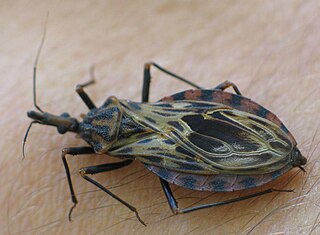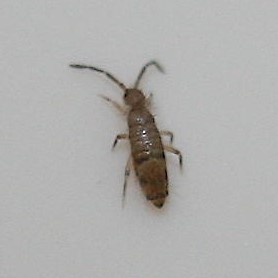
Triatoma nigromaculata is a sylvatic species of insect usually found in hollow trees, in vertebrate nests on trees and occasionally in human dwellings. It usually lives in relatively humid forests at high altitudes on mountain regions and foot hills. As all members of the subfamily Triatominae, T. nigromaculata is a blood-sucking bug and a potential vector of Chagas disease. This species is distributed mainly in Venezuela, but some specimens have also been found in Perú and Colombia (Cauca).
Cardioglossa nigromaculata is a species of frog in the family Arthroleptidae. It is found in the south-western Cameroon and in the extreme southern Nigeria at low altitudes. Common name blackspotted long-fingered frog has been coined for it.
Pseudoeurycea nigromaculata, commonly known as the black-spotted salamander or black-spotted false brook salamander is a species of salamander in the family Plethodontidae. It is endemic to Veracruz, Mexico, and known from Cerro Chicahuaxtla ) in Cuatlalpan and from Volcán San Martín at elevations of 1,200–1,300 m (3,900–4,300 ft). These separate populations likely represent distinct species.

Phlegopsis is a genus of insectivorous passerine birds in the antbird family, Thamnophilidae. They are known as "bare-eyes", which is a reference to a colourful bare patch of skin around their eyes. They are restricted to humid forest in the Amazon of South America. They are among the largest ant-followers in the family and are only rarely seen away from ant swarms.

The black-spotted bare-eye is a species of insectivore passerine bird in subfamily Thamnophilinae of family Thamnophilidae, the "typical antbirds". It is found in Bolivia, Brazil, Colombia, Ecuador, and Peru.

Willowsia nigromaculata is a member of the family Entomobryidae. It has a metallic iridescent body and is covered in translucent scales. It is often found indoors in places such as houses, garages and greenhouses.
Tochuina nigromaculata is a species of dendronotid nudibranch. It is a marine gastropod mollusc in the family Tritoniidae.
Carposina nigromaculata is a moth of the family Carposinidae. It was first described by Lord Walsingham in 1907. It is endemic to the Hawaiian island of Oahu.

Mictocommosis nigromaculata is a species of moth of the family Tortricidae. It is found in Japan, as well as Vietnam and Taiwan.

Saperdini is a tribe of longhorn beetles of the subfamily Lamiinae.
Heteroglenea is a genus of longhorn beetles of the subfamily Lamiinae, containing the following species:

Zeale nigromaculata is a species of beetle in the family Cerambycidae. It was described by Johann Christoph Friedrich Klug in 1829. It is known from Argentina, Brazil, Paraguay, and Uruguay.
Heteroglenea dolosa is a species of beetle in the family Cerambycidae. It was described by Lin and Yang in 2009. It is known from Laos.
Heteroglenea gemella is a species of beetle in the family Cerambycidae. It was described by Lin and Yang in 2009. It is known from Nepal.
Heteroglenea vicinalis is a species of beetle in the family Cerambycidae. It was described by Lin and Yang in 2009. It is known from Nepal and India.
Heteroglenea bastiensis is a species of beetle in the family Cerambycidae. It was described by Stephan von Breuning in 1956. It is known from India.
Heteroglenea momeitensis is a species of beetle in the family Cerambycidae. It was described by Stephan von Breuning in 1956. It is known from Myanmar.
Heteroglenea fissilis is a species of beetle in the family Cerambycidae. It was described by Stephan von Breuning in 1953. It is known from Myanmar, India, Bangladesh, Laos, China, and Thailand. It feeds on Dialium cochinchinense.
Heteroglenea mediodiscoprolongata is a species of beetle in the family Cerambycidae. It was described by Stephan von Breuning in 1964, originally under the genus Glenea. It is known from Laos, China, and Thailand.
Heteroglenea glechoma is a species of beetle in the family Cerambycidae. It was described by Francis Polkinghorne Pascoe in 1867, originally under the genus Glenea. It is known from Papua New Guinea, Japan, the Solomon Islands, Moluccas, the Philippines, Java, Taiwan, and Sumatra.





